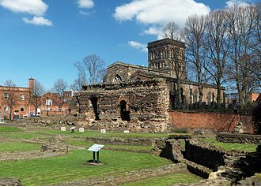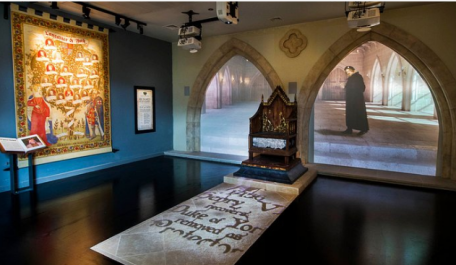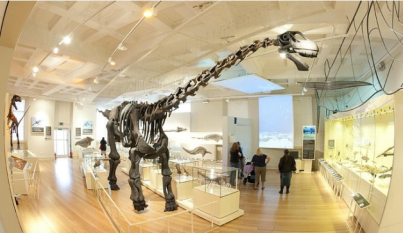Leicester, Leicestershire, England, UK
I. Population and Area
Continent: Europe
Country: The U.K
State/Province: England
City/Town: Leicester, Leicestershire
Total Area: 28.3(sq mi)
Population in 2011: 329.8(thousand)
II. Natural Geography (environment and resources)

Climate
Leicester experiences a maritime climate with mild to warm summers and cool winters, rain spread throughout the year, and low sunshine levels. The nearest official Weather Station was Newtown Linford, about 5 miles (8.0 km) northwest of Leicester city centre and just outside the edge of the urban area. However, observations stopped there in 2003.The current nearest weather station is Market Bosworth, about 10 miles (16 km) west of the city centre.[citation needed
Air
East Midlands Airport (EMA), at Castle Donington 20 miles (32 km) north northwest of the city is the closest international airport. The airport is a national hub for mail/freight networks.
Leicester Airport (LRC) is a small airport some 6 miles (10 km) east of Leicester City Centre and does not operate scheduled services.
Road
Burleys Way, Leicester, England.
Leicester is at the midpoint; Junctions 21, 21A and 22, of the primary English north/south M1 motorway between London and Leeds/York. This is where the M1 motorway transects with one of the primary northeast–southwest routes; the M69 motorway/A46 corridor linking to the A1 and M6 motorway at Newark-on-Trent and Coventry respectively. The M42 motorway towards Birmingham Airport terminates in North West Leicestershire some 12 miles (19 km) west northwest of the Leicester urban area. Leicester is at the nexus of the A6/(A14), A50, A47 and A607 trunk roads and A426 and A5199 primary routes.
National Cycle Network
National Cycle Network Route 6 passes through Leicestershire along with other secondary routes. The Leicester Bike Park is in Town Hall Square. 'Cycle Works' Bike Mechanic Training Centre is in Wellington Street Adult Education Centre and former Central Lending Library.
Rail
Leicester railway station lies on the eastern side of the city centre on the A6 London Road.
The rail network is of growing importance in Leicester, and with the start of Eurostar international services from London St Pancras International in November 2007 Leicester railway station has gained connections at St Pancras station to Lille, Brussels and Paris onwards.
InterCity services are operated by East Midlands Railway providing connectivity on 'fast' and 'semi-fast' services to London and the south east, and to major cities and towns in the East Midlands and Yorkshire in addition to providing local services within the East Midlands region. Trans-regional services to the West Midlands and East Anglia are provided by CrossCountry, enabling connexions at nearby Nuneaton onto the West Coast mainline and at Peterborough with the East Coast mainline.
III. GDP
Metropolitan area GDP
$27.5 bn, (2012, PPP)
IV. Industrial Characterisitics
Major industries:Leicester's industrial wealth was built on three core industries: hosiery, boot and shoe manufacture and engineering. The third of these was often linked to the first two, as in the case of J. Hobley and Co. Ltd, a manufacturer of textile machinery founded by John Henry Milward Hobley in the early 20th century.
Big project:SURE Projects 2020
V. Attractions
1. King Richard III Visitor Centre:

They have made a wonderful exhibit which covers all of the areas of interest from his life to his recent discover, the grave site has been preserved with a glass covered top which allows you to really look at.
2. National Space Centre:

I love the fact you can have an annual pass as we're yet to watch a show without it being full of school kids lol The restaurant is reasonably priced and has a good selection of snacks and treats.
3. New Walk Museum and Art Gallery:

The dinosaur exhibit is great and my daughter also loves the animal room with all of the stuffed animals and little tunnels for her to crawl through and pop her head out of!
VI. History
Prehistory
Leicester is one of the oldest cities in England, with a history going back at least two millennia.[citation needed] The native Iron Age settlement encountered by the Romans at the site seems to have developed in the 2nd or 1st centuries BC. Little is known about this settlement or the condition of the River Soar at this time, although roundhouses from this era have been excavated and seem to have clustered along roughly 8 hectares (20 acres) of the east bank of the Soar above its confluence with the Trent. This area of the Soar was split into two channels: a main stream to the east and a narrower channel on the west, with a presumably marshy island between. The settlement seems to have controlled a ford across the larger channel. The later Roman name was a latinate form of the Brittonic word for "ramparts" (cf. Gaelic rath and the nearby villages of Ratby and Ratcliffe[14]), suggesting the site was an oppidum. The plural form of the name suggests it was initially composed of several villages. The Celtic tribe holding the area was later recorded as the "Coritanians" but an inscription recovered in 1983 showed this to have been a corruption of the original "Corieltauvians". The Corieltauvians are believed to have ruled over roughly the area of the East Midlands.
Roman St Nicholas's Church and the Jewry Wall.
Main article: Ratae Corieltauvorum
It is believed that the Romans arrived in the Leicester area around AD 47, during their conquest of southern Britain.[17] The Corieltauvian settlement lay near a bridge on the Fosse Way, a Roman road between the legionary camps at Isca (Exeter) and Lindum (Lincoln). It remains unclear whether the Romans fortified and garrisoned the location, but it slowly developed from around the year 50 onwards as the tribal capital of the Corieltauvians under the name Ratae Corieltauvorum. In the 2nd century, it received a forum and bathhouse. In 2013, the discovery of a Roman cemetery found just outside the old city walls and dating back to ad 300 was announced. The remains of the baths of Roman Leicester can be seen at the Jewry Wall; recovered artifacts are displayed at the adjacent museum.
Leicester Cathedral
Knowledge of the town following the Roman withdrawal from Britain is limited. Certainly there is some continuation of occupation of the town, though on a much reduced scale in the 5th and 6th centuries. Its memory was preserved as the Cair Lerion of the History of the Britons. Following the Saxon invasion of Britain, Leicester was occupied by the Middle Angles and subsequently administered by the kingdom of Mercia. It was elevated to a bishopric in either 679 or 680; this see survived until the 9th century, when Leicester was captured by Danish Vikings. Their settlement became one of the Five Burghs of the Danelaw, although this position was short-lived. The Saxon bishop, meanwhile, fled to Dorchester-on-Thames and Leicester did not become a bishopric again until the Church of St Martin became Leicester Cathedral in 1927. The settlement was recorded under the name Ligeraceaster in the early 10th century.
Leicester Guildhall, dating from the 14th century
Following the Norman conquest, Leicester was recorded by William's Domesday Book as Ledecestre. It was noted as a city (civitas) but lost this status in the 11th century owing to power struggles between the Church and the aristocracy and did not become a legal city again until 1919.
Geoffrey of Monmouth composed his History of the Kings of Britain around the year 1136, naming a King Leir as an eponymous founder figure.According to Geoffrey's narrative, Cordelia had buried her father beneath the river in a chamber dedicated to Janus and his feast day was an annual celebration.
When Simon de Montfort became Lord of Leicester in 1231, he gave the city a grant to expel the Jewish population "in my time or in the time of any of my heirs to the end of the world". He justified his action as being "for the good of my soul, and for the souls of my ancestors and successors". Leicester's Jews were allowed to move to the eastern suburbs, which were controlled by de Montfort's great-aunt and rival, Margaret, Countess of Winchester, after she took advice from the scholar and cleric Robert Grosseteste. There is evidence that Jews remained there until 1253, and perhaps enforcement of the banishment within the city was not rigorously enforced. De Montfort however issued a second edict for the expulsion of Leicester's Jews in 1253, after Grosseteste's death. De Montfort's many acts of anti-Jewish persecution in Leicester and elsewhere mass murder were part of a wider pattern that led to the expulsion of the Jewry from England in 1290.
During the C14th the earls of Leicester and Lancaster enhanced the prestige of the town. Henry, 3rd Earl of Lancaster and of Leicester founded a hospital for the poor and infirm in the area to the south of the castle now known as The Newarke (the "new work"). Henry's son, the great Henry of Grosmont, 4th Earl of Lancaster and of Leicester, who was made first Duke of Lancaster, enlarged and enhanced his father's foundation, and built the collegiate Church of the Annunciation of Our Lady of The Newarke.[28] This church (a little of which survives in the basement of the Hawthorn Building of De Montfort University) was destroyed during the reign of King Edward VI. It became an important pilgrimage site because it housed a thorn said to be from the Crown of Thorns, given to the Duke by the King of France. The church (described by Leland in the C16th as "not large but exceeding fair") also became, effectively, a Lancastrian mausoleum. Duke Henry's daughter Blanche of Lancaster married John of Gaunt and their son Henry Bolingbroke became King Henry IV when he deposed King Richard II. The Church of the Annunciation was the burial place of Duke Henry, who had earlier had his father re-interred here. Later it became the burial place of Constance of Castile, Duchess of Lancaster (second wife of John of Gaunt) and of Mary de Bohun, first wife of Henry Bolingbroke (Henry IV) and mother of King Henry V (she did not become queen because she died before Bolingbroke became king). John of Gaunt died at Leicester Castle in 1399. When his son became king, the Earldom of Leicester and the Duchy of Lancaster became royal titles (and the latter remains so).
VII. Culture
The city hosts annually a Caribbean Carnival and parade (the largest in the UK outside London), Diwali celebrations (the largest outside of India) ,the largest comedy festival in the UK Leicester Comedy Festival and a Pride Parade (Leicester Pride). Belgrave Road, not far from the city centre, is colloquially known as "The Golden Mile" because of the number of Jewellers.
The Leicester International Short Film Festival is an annual event; it commenced in 1996 under the banner title of "Seconds Out". It has become one of the most important short film festivals in the UK and usually runs in early November, with venues including the Phoenix Square. Phoenix Square cinema and media complex. Notable arts venues in the city include: Curve: Purpose-designed performing arts centre, designed by Rafael Viñoly, opened in Autumn 2008,. The Peepul Centre, Designed by Andrzej Blonski Architects, the £15 million building was opened in 2005 and houses an auditorium, restaurant, cyber café, gym and dance studio for the local people, as well as being used for conferences and events. The centre has even been host to former Prime Minister Gordon Brown and other senior Labour Party figures for hustings during the deputy leadership contest.
Phoenix Square, which in 2009, replaced the Phoenix Arts Centre.
The Sue Townsend Theatre - which opened in the former Phoenix Arts Centre.
VIII. Other information
Leicester is home to the Leicester Mercury newspaper, and the Midlands Asian Television channel known as MATV Channel 6.
Film crew at work during an "anti-Fascist" march in Leicester, August 1974
BBC Radio Leicester was the first BBC Local Radio station in Britain, opening on 8 November 1967. Other analogue FM radio stations are Leicester Community Radio for English speaking over 35's (1449 AM/MW), Demon FM which is Leicester's community and student radio station broadcasting from Demontfort University, Takeover Radio is the first ever children's radio station in the UK to be produced and presented by children, Capital FM East Midlands Gem 106, 106.6 Smooth Radio and Hindu Sanskar Radio, which only broadcasts during Hindu religious festivals. BBC Asian Network and Sabras Radio broadcast on AM.
____________________________________________________________________________________
IX. Contact information
Mayor/Officer: Peter Soulsby
Tel: 0116 223 1225
Mail: internationalcpd@leicester.ac.uk
